2004 ISUZU TF SERIES coolant
[x] Cancel search: coolantPage 1532 of 4264
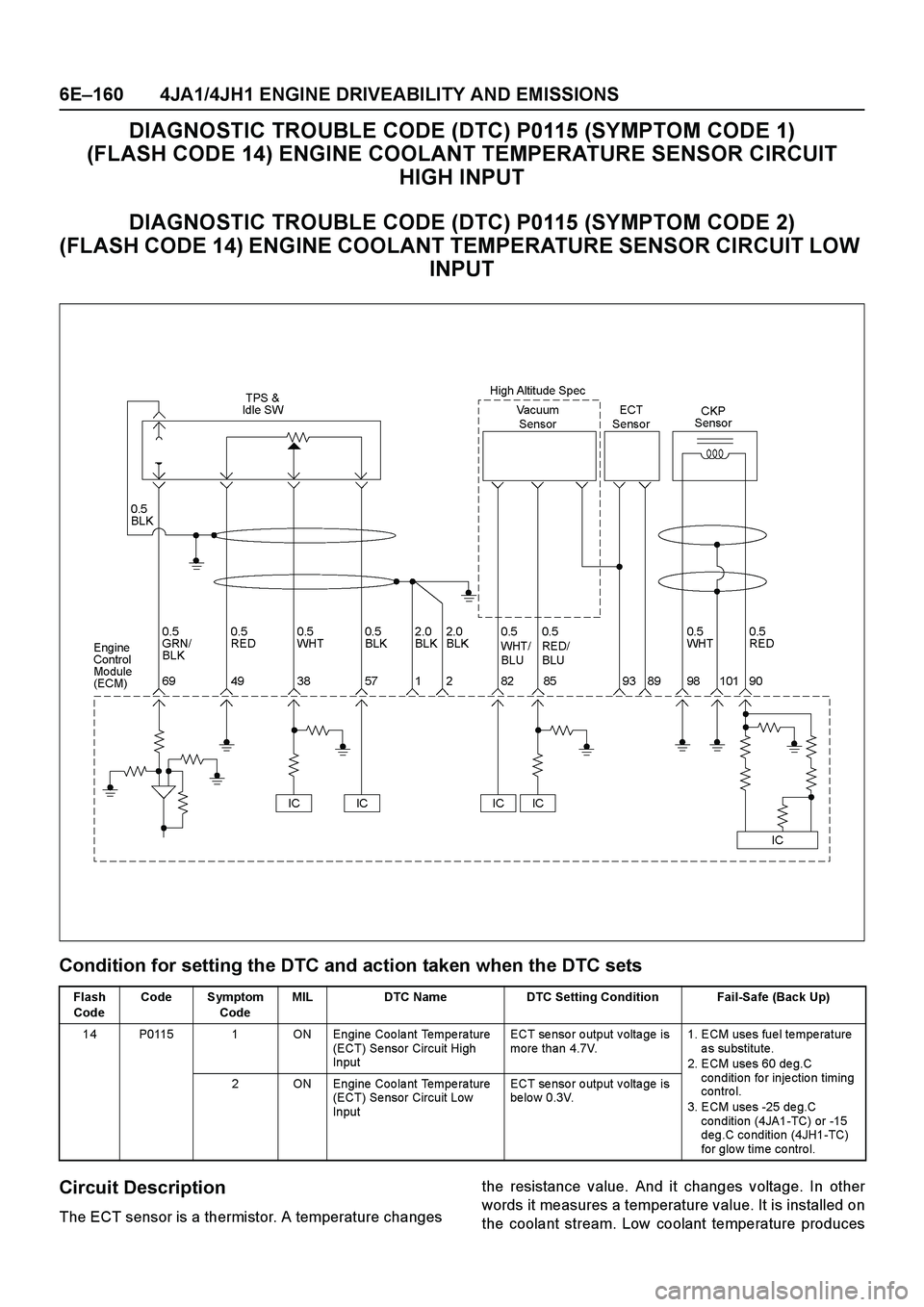
6E–160 4JA1/4JH1 ENGINE DRIVEABILITY AND EMISSIONS
DIAGNOSTIC TROUBLE CODE (DTC) P0115 (SYMPTOM CODE 1)
(FLASH CODE 14) ENGINE COOLANT TEMPERATURE SENSOR CIRCUIT
HIGH INPUT
DIAGNOSTIC TROUBLE CODE (DTC) P0115 (SYMPTOM CODE 2)
(FLASH CODE 14) ENGINE COOLANT TEMPERATURE SENSOR CIRCUIT LOW
INPUT
Condition for setting the DTC and action taken when the DTC sets
Circuit Description
The ECT sensor is a thermistor. A temperature changesthe resistance value. And it changes voltage. In other
words it measures a temperature value. It is installed on
the coolant stream. Low coolant temperature produces
Flash
CodeCode Symptom
CodeMIL DTC Name DTC Setting Condition Fail-Safe (Back Up)
14 P0115 1 ON Engine Coolant Temperature
(ECT) Se nsor Circuit High
InputECT sensor output voltage is
more than 4.7V.1. ECM uses fue l te mpe rature
as substitute.
2. ECM uses 60 de g.C
condition for injection timing
contro l.
3. ECM uses -25 de g.C
condition (4JA1-TC) or -15
deg.C condition (4JH1-TC)
for glo w time co ntro l. 2 ON Engine Coolant Temperature
(ECT) Se nsor Circuit Low
InputECT sensor output voltage is
be lo w 0.3V.
Page 1533 of 4264
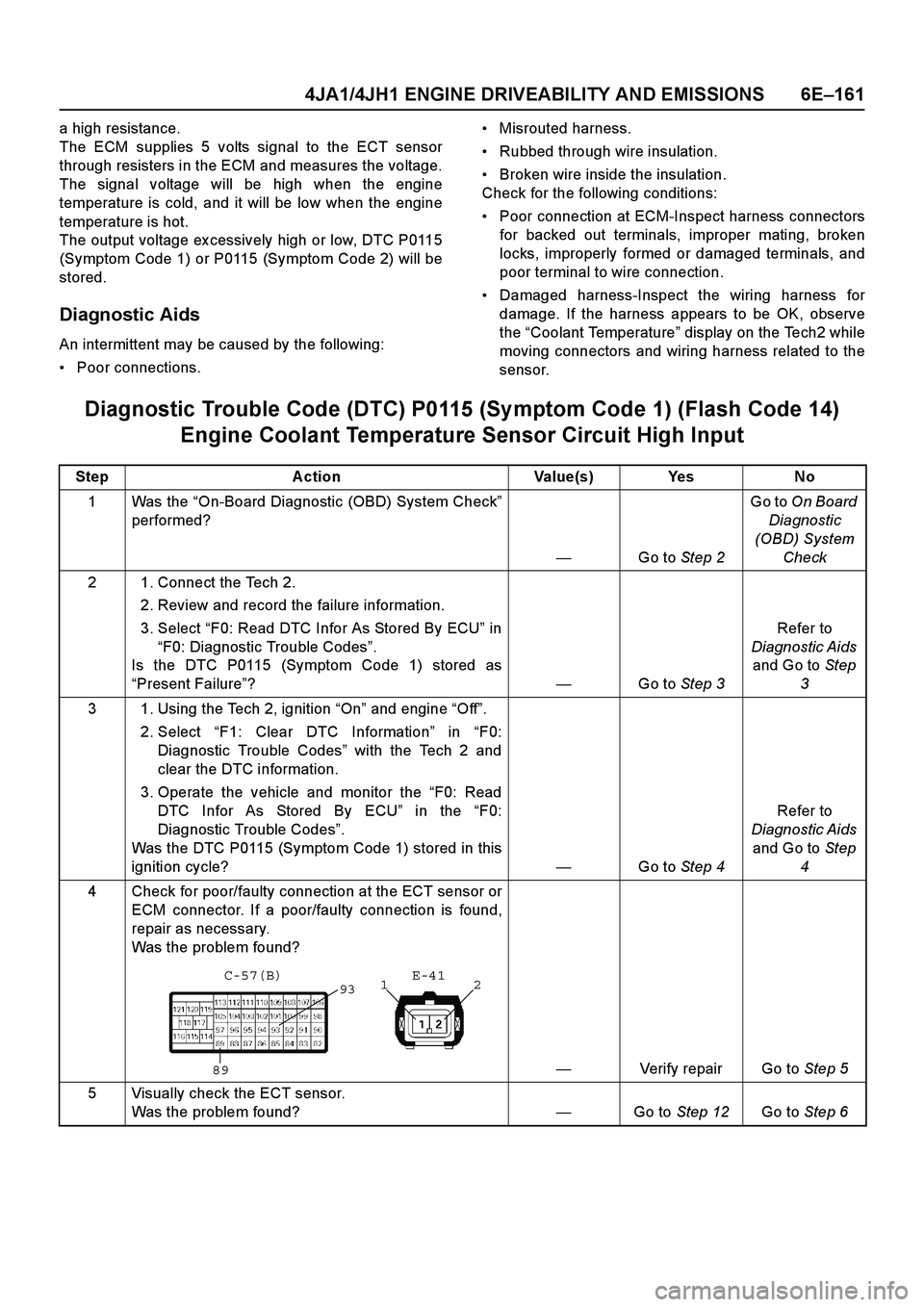
4JA1/4JH1 ENGINE DRIVEABILITY AND EMISSIONS 6E –161
a high resistance.
The ECM supplies 5 volts signal to the ECT sensor
through resisters in the ECM and measures the voltage.
The signal voltage will be high when the engine
temperature is cold, and it will be low when the engine
temperature is hot.
The output voltage ex cessively high or low, DTC P0115
(Symptom Code 1) or P0115 (Symptom Code 2) will be
stored.
Diagnostic Aids
An intermittent may be caused by the following:
Poor connections.
Misrouted harness.
Rubbed through wire insulation.
Broken wire inside the insulation.
Check for the following conditions:
Poor connection at ECM-Inspect harness connectors
for backed out terminals, improper mating, broken
locks, improperly formed or damaged terminals, and
poor terminal to wire connection.
Damaged harness-Inspect the wiring harness for
damage. If the harness appears to be OK, observe
the “Coolant Temperature ” display on the Tech2 while
moving connectors and wiring harness related to the
sensor.
Diagnostic Trouble Code (DTC) P0115 (Sy mptom Code 1) (Flash Code 14)
Engine Coolant Temperature Sensor Circuit High Input
Step Action Value(s) Yes No
1Was the “On-Board Diagnostic (OBD) System Check ”
performed?
— Go to Step 2 Go to
On Board
Diagnostic
(OBD) System Check
2 1. Connect the Tech 2. 2. Review and record the failure information.
3. Select “F0: Read DTC Infor As Stored By ECU ” in
“ F0: Diagnostic Trouble Codes ”.
Is the DTC P0115 (Symptom Code 1) stored as
“ Present Failure ”? —Go to Step 3 Refer to
Diagnostic Aids and Go to Step
3
3 1. Using the Tech 2, ignition “On ” and engine “Off ”.
2. Select “F1: Clear DTC Information ” in “F0:
Diagnostic Trouble Codes ” with the Tech 2 and
clear the DTC information.
3. Operate the vehicle and monitor the “F0: Read
DTC Infor As Stored By ECU ” in the “F0:
Diagnostic Trouble Codes ”.
Was the DTC P0115 (Symptom Code 1) stored in this
ignition cycle? —Go to Step 4 Refer to
Diagnostic Aids and Go to Step
4
4 Check for poor/faulty connection at the ECT sensor or ECM connector. If a poor/faulty connection is found,
repair as necessary.
Was the problem found?
— Verify repair Go to Step 5
5 Visually check the ECT sensor. Was the problem found? —Go to Step 12 Go to Step 6
932
1
89 E-41
C-57(B)
Page 1537 of 4264
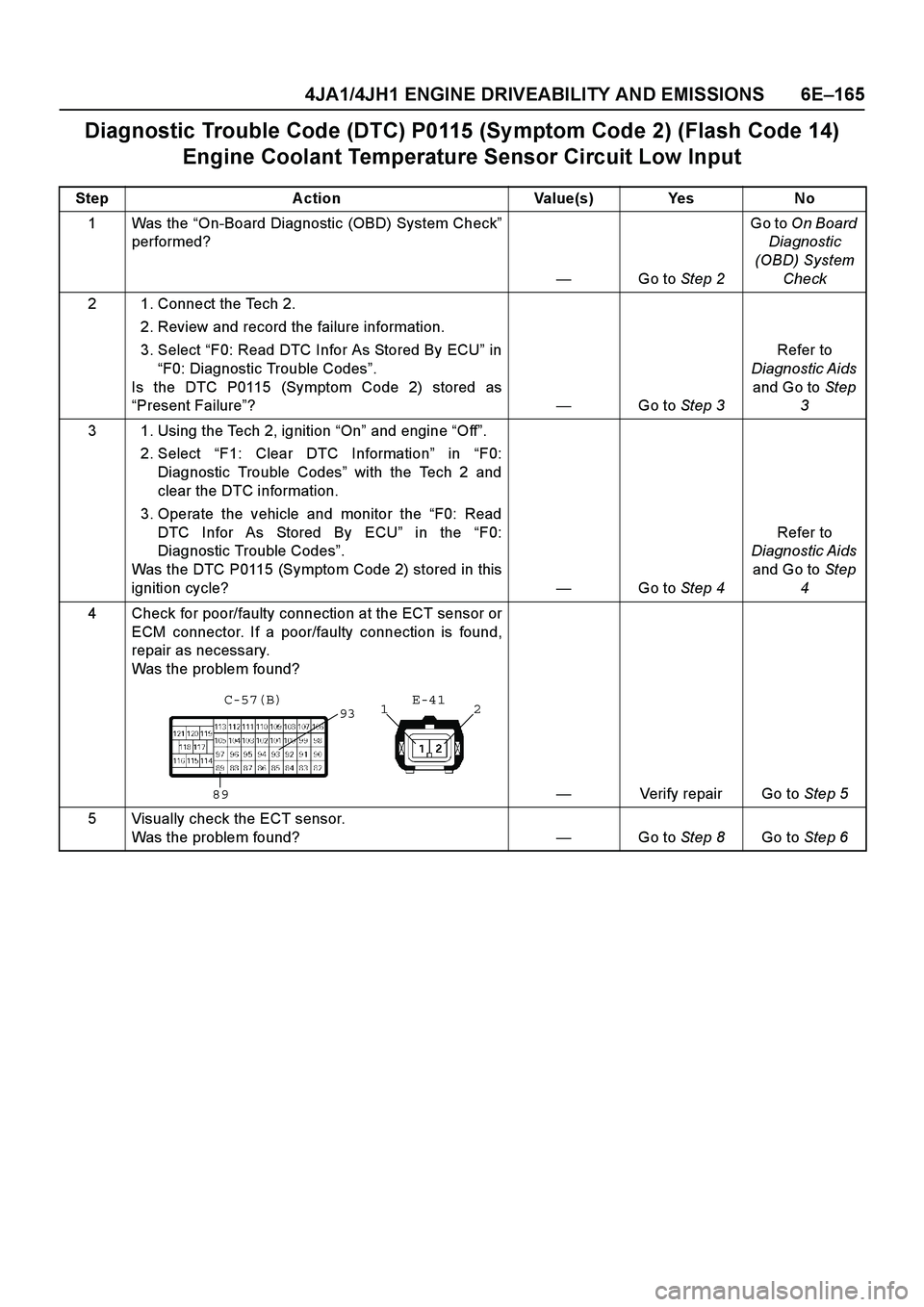
4JA1/4JH1 ENGINE DRIVEABILITY AND EMISSIONS 6E –165
Diagnostic Trouble Code (DTC) P0115 (Sy mptom Code 2) (Flash Code 14)
Engine Coolant Temperature Sensor Circuit Low Input
Step Action Value(s) Yes No
1Was the “On-Board Diagnostic (OBD) System Check ”
performed?
— Go to Step 2 Go to
On Board
Diagnostic
(OBD) System Check
2 1. Connect the Tech 2. 2. Review and record the failure information.
3. Select “F0: Read DTC Infor As Stored By ECU ” in
“ F0: Diagnostic Trouble Codes ”.
Is the DTC P0115 (Symptom Code 2) stored as
“ Present Failure ”? —Go to Step 3 Refer to
Diagnostic Aids and Go to Step
3
3 1. Using the Tech 2, ignition “On ” and engine “Off ”.
2. Select “F1: Clear DTC Information ” in “F0:
Diagnostic Trouble Codes ” with the Tech 2 and
clear the DTC information.
3. Operate the vehicle and monitor the “F0: Read
DTC Infor As Stored By ECU ” in the “F0:
Diagnostic Trouble Codes ”.
Was the DTC P0115 (Symptom Code 2) stored in this
ignition cycle? —Go to Step 4 Refer to
Diagnostic Aids and Go to Step
4
4 Check for poor/faulty connection at the ECT sensor or ECM connector. If a poor/faulty connection is found,
repair as necessary.
Was the problem found?
— Verify repair Go to Step 5
5 Visually check the ECT sensor. Was the problem found? —Go to Step 8 Go to Step 6
932
1
89 E-41
C-57(B)
Page 1551 of 4264
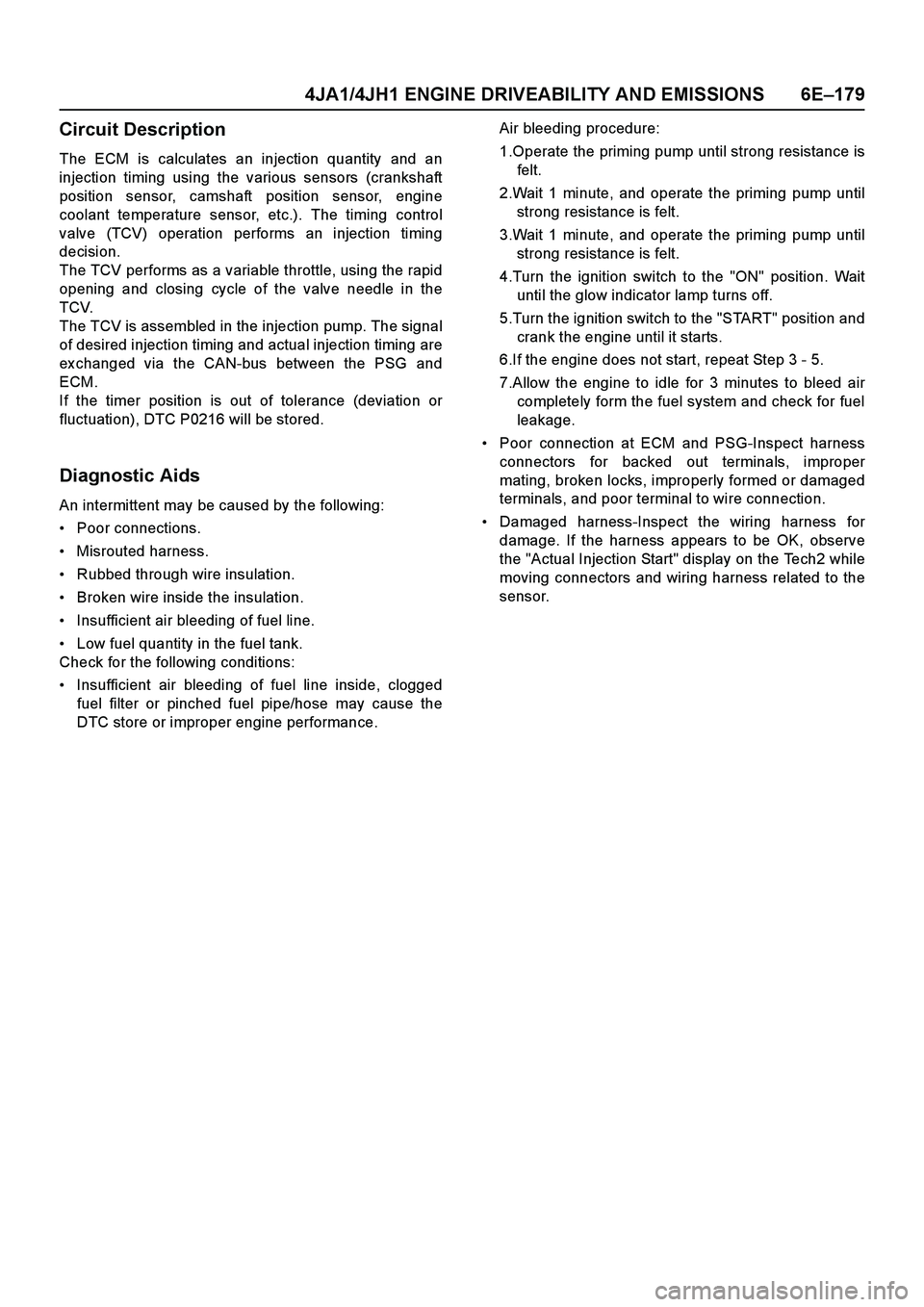
4JA1/4JH1 ENGINE DRIVEABILITY AND EMISSIONS 6E–179
Circuit Description
The ECM is calculates an injection quantity and an
injection timing using the various sensors (crankshaft
position sensor, camshaft position sensor, engine
coolant temperature sensor, etc.). The timing control
valve (TCV) operation performs an injection timing
decision.
The TCV performs as a variable throttle, using the rapid
opening and closing cycle of the valve needle in the
TCV.
The TCV is assembled in the injection pump. The signal
of desired injection timing and actual injection timing are
ex changed via the CAN-bus between the PSG and
ECM.
If the timer position is out of tolerance (deviation or
fluctuation), DTC P0216 will be stored.
Diagnostic Aids
An intermittent may be caused by the following:
Poor connections.
Misrouted harness.
Rubbed through wire insulation.
Broken wire inside the insulation.
Insufficient air bleeding of fuel line.
Low fuel quantity in the fuel tank.
Check for the following conditions:
Insufficient air bleeding of fuel line inside, clogged
fuel filter or pinched fuel pipe/hose may cause the
DTC store or improper engine performance.Air bleeding procedure:
1.Operate the priming pump until strong resistance is
felt.
2.Wait 1 minute, and operate the priming pump until
strong resistance is felt.
3.Wait 1 minute, and operate the priming pump until
strong resistance is felt.
4.Turn the ignition switch to the "ON" position. Wait
until the glow indicator lamp turns off.
5.Turn the ignition switch to the "START" position and
crank the engine until it starts.
6.If the engine does not start, repeat Step 3 - 5.
7.Allow the engine to idle for 3 minutes to bleed air
completely form the fuel system and check for fuel
leakage.
Poor connection at ECM and PSG-Inspect harness
connectors for backed out terminals, improper
mating, broken locks, improperly formed or damaged
terminals, and poor terminal to wire connection.
Damaged harness-Inspect the wiring harness for
damage. If the harness appears to be OK, observe
the "Actual Injection Start" display on the Tech2 while
moving connectors and wiring harness related to the
sensor.
Page 1556 of 4264
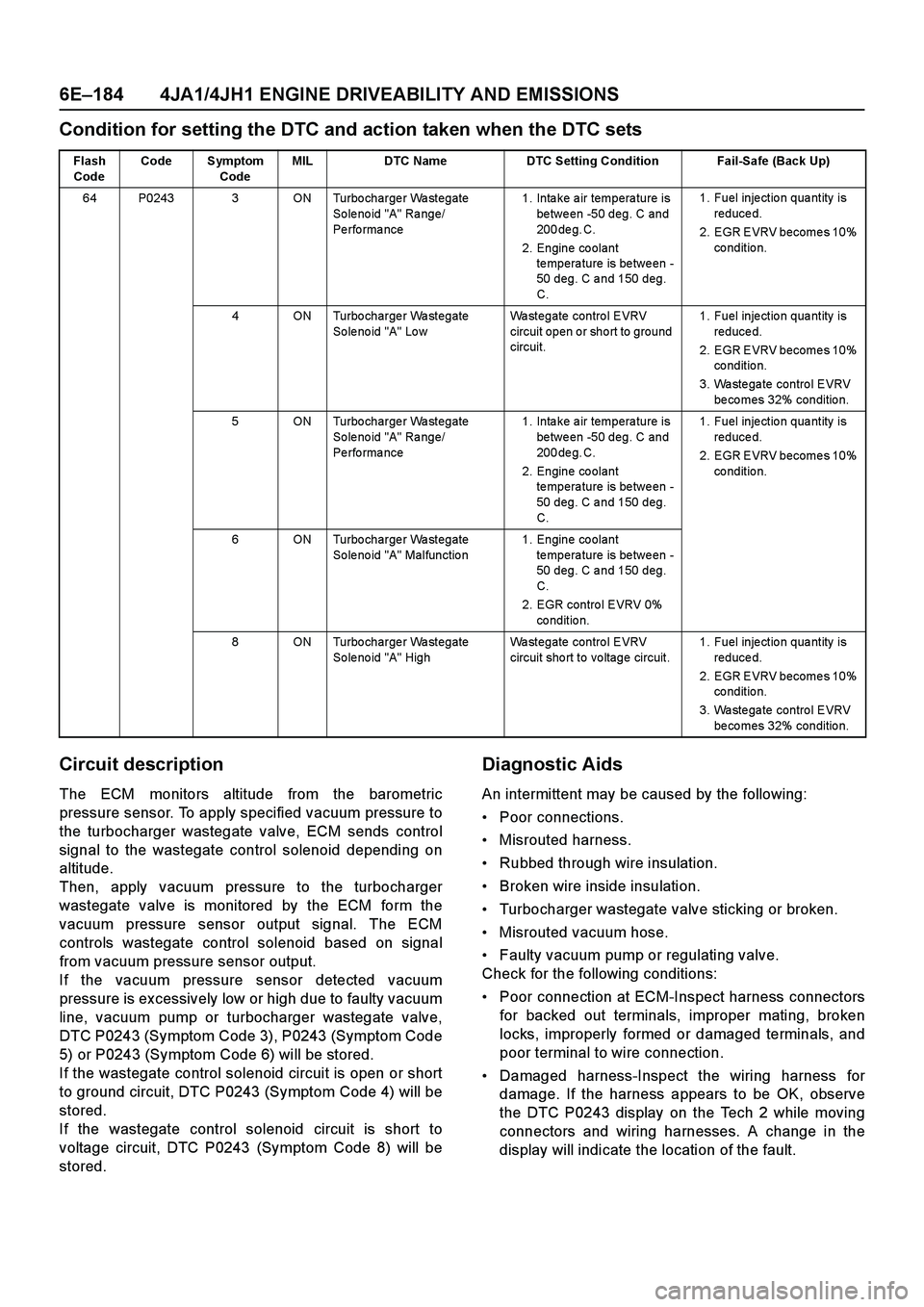
6E–184 4JA1/4JH1 ENGINE DRIVEABILITY AND EMISSIONS
Condition for setting the DTC and action taken when the DTC sets
Circuit description
The ECM monitors altitude from the barometric
pressure sensor. To apply specified vacuum pressure to
the turbocharger wastegate valve, ECM sends control
signal to the wastegate control solenoid depending on
altitude.
Then, apply vacuum pressure to the turbocharger
wastegate valve is monitored by the ECM form the
vacuum pressure sensor output signal. The ECM
controls wastegate control solenoid based on signal
from vacuum pressure sensor output.
If the vacuum pressure sensor detected vacuum
pressure is excessively low or high due to faulty vacuum
line, vacuum pump or turbocharger wastegate valve,
DTC P0243 (Symptom Code 3), P0243 (Symptom Code
5) or P0243 (Symptom Code 6) will be stored.
If the wastegate control solenoid circuit is open or short
to ground circuit, DTC P0243 (Symptom Code 4) will be
stored.
If the wastegate control solenoid circuit is short to
voltage circuit, DTC P0243 (Symptom Code 8) will be
stored.
Diagnostic Aids
An intermittent may be caused by the following:
Poor connections.
Misrouted harness.
Rubbed through wire insulation.
Broken wire inside insulation.
Turbocharger wastegate valve sticking or broken.
Misrouted vacuum hose.
Faulty vacuum pump or regulating valve.
Check for the following conditions:
Poor connection at ECM-Inspect harness connectors
for backed out terminals, improper mating, broken
locks, improperly formed or damaged terminals, and
poor terminal to wire connection.
Damaged harness-Inspect the wiring harness for
damage. If the harness appears to be OK, observe
the DTC P0243 display on the Tech 2 while moving
connectors and wiring harnesses. A change in the
display will indicate the location of the fault.
Flash
CodeCode Symptom
CodeMIL DTC Name DTC Setting Condition Fail-Safe (Back Up)
64 P0243 3 ON Turbocharger Wastegate
So le no id "A" Ra nge/
Pe rfo rma nce1. Intake air temperature is
between -50 deg. C and
2 0 0 d e g . C .
2. Engine coolant
temperature is between -
50 deg. C and 150 deg.
C. 1. Fuel injection quantity is
r e d u c e d .
2. EGR EVRV becomes 10%
co nditio n.
4 ON Turbocharger Wastegate
So le no id "A" Lo w Wastegate control EVRV
circuit open or short to ground
circuit.1. Fuel injection quantity is
r e d u c e d .
2. EGR EVRV becomes 10%
c o n d i t i o n .
3. Wastegate control EVRV
be co mes 32% conditio n.
5 ON Turbocharger Wastegate
So le no id "A" Ra nge/
Pe rfo rma nce1. Intake air temperature is
between -50 deg. C and
2 0 0 d e g . C .
2. Engine coolant
temperature is between -
50 deg. C and 150 deg.
C. 1. Fuel injection quantity is
r e d u c e d .
2. EGR EVRV becomes 10%
co nditio n.
6 ON Turbocharger Wastegate
So le no id "A" Malfunctio n1. Engine coolant
temperature is between -
50 deg. C and 150 deg.
C .
2. EGR contro l EVRV 0%
co nditio n.
8 ON Turbocharger Wastegate
So le no id "A" HighWastegate control EVRV
circuit short to voltage circuit.1. Fuel injection quantity is
r e d u c e d .
2. EGR EVRV becomes 10%
c o n d i t i o n .
3. Wastegate control EVRV
be co mes 32% conditio n.
Page 1589 of 4264
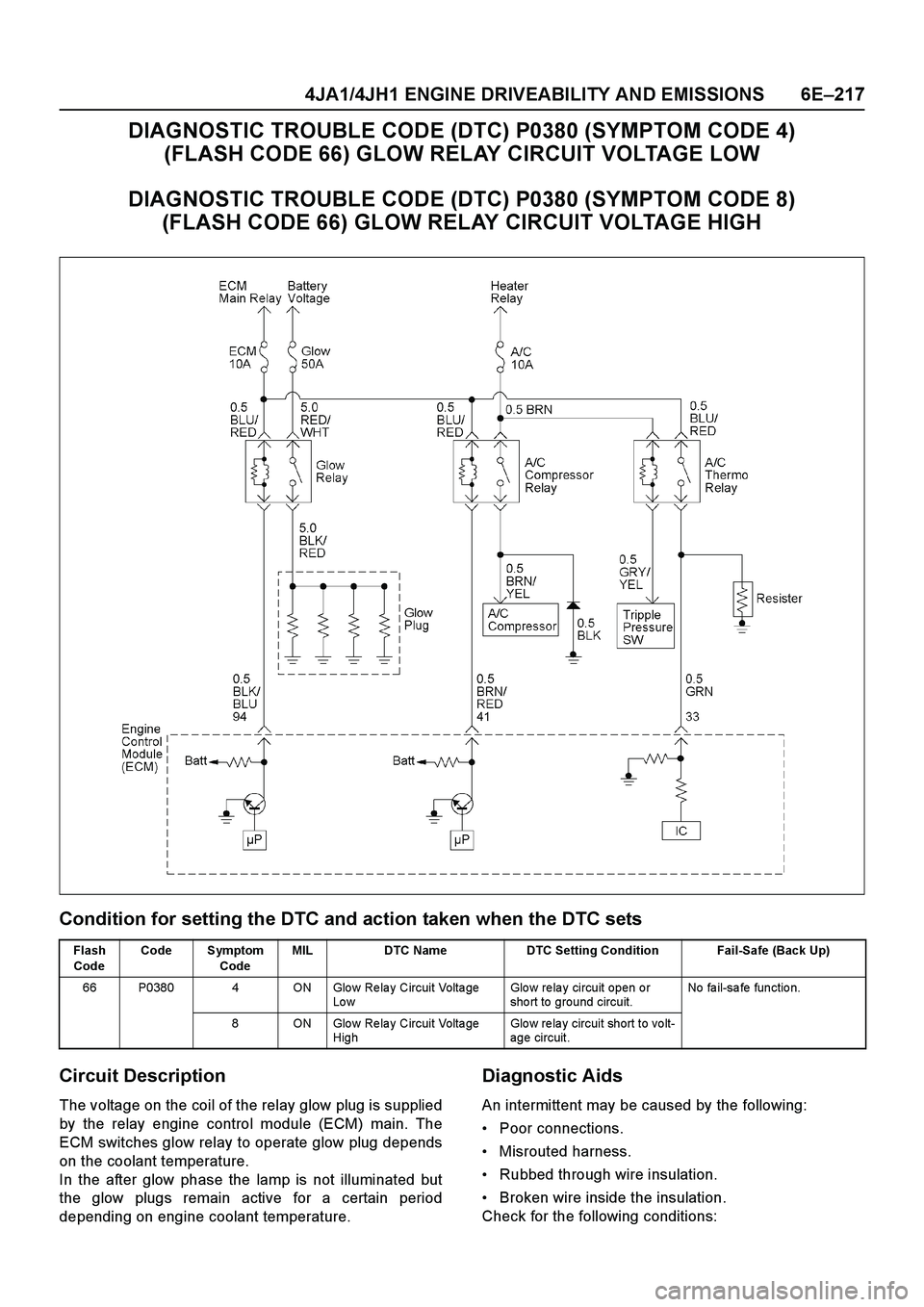
4JA1/4JH1 ENGINE DRIVEABILITY AND EMISSIONS 6E–217
DIAGNOSTIC TROUBLE CODE (DTC) P0380 (SYMPTOM CODE 4)
(FLASH CODE 66) GLOW RELAY CIRCUIT VOLTAGE LOW
DIAGNOSTIC TROUBLE CODE (DTC) P0380 (SYMPTOM CODE 8)
(FLASH CODE 66) GLOW RELAY CIRCUIT VOLTAGE HIGH
Condition for setting the DTC and action taken when the DTC sets
Circuit Description
The voltage on the coil of the relay glow plug is supplied
by the relay engine control module (ECM) main. The
ECM switches glow relay to operate glow plug depends
on the coolant temperature.
In the after glow phase the lamp is not illuminated but
the glow plugs remain active for a certain period
depending on engine coolant temperature.
Diagnostic Aids
An intermittent may be caused by the following:
Poor connections.
Misrouted harness.
Rubbed through wire insulation.
Broken wire inside the insulation.
Check for the following conditions:
Flash
CodeCode Symptom
CodeMIL DTC Name DTC Setting Condition Fail-Safe (Back Up)
66 P0380 4 ON Glo w Re la y Circuit Volta ge
Lo wGlow relay circuit open or
sho rt to ground circuit.No fa il-sa fe fun ctio n.
8 ON Glo w Re la y Circuit Volta ge
HighGlo w re la y circuit short to vo lt-
age circuit.
Page 1594 of 4264
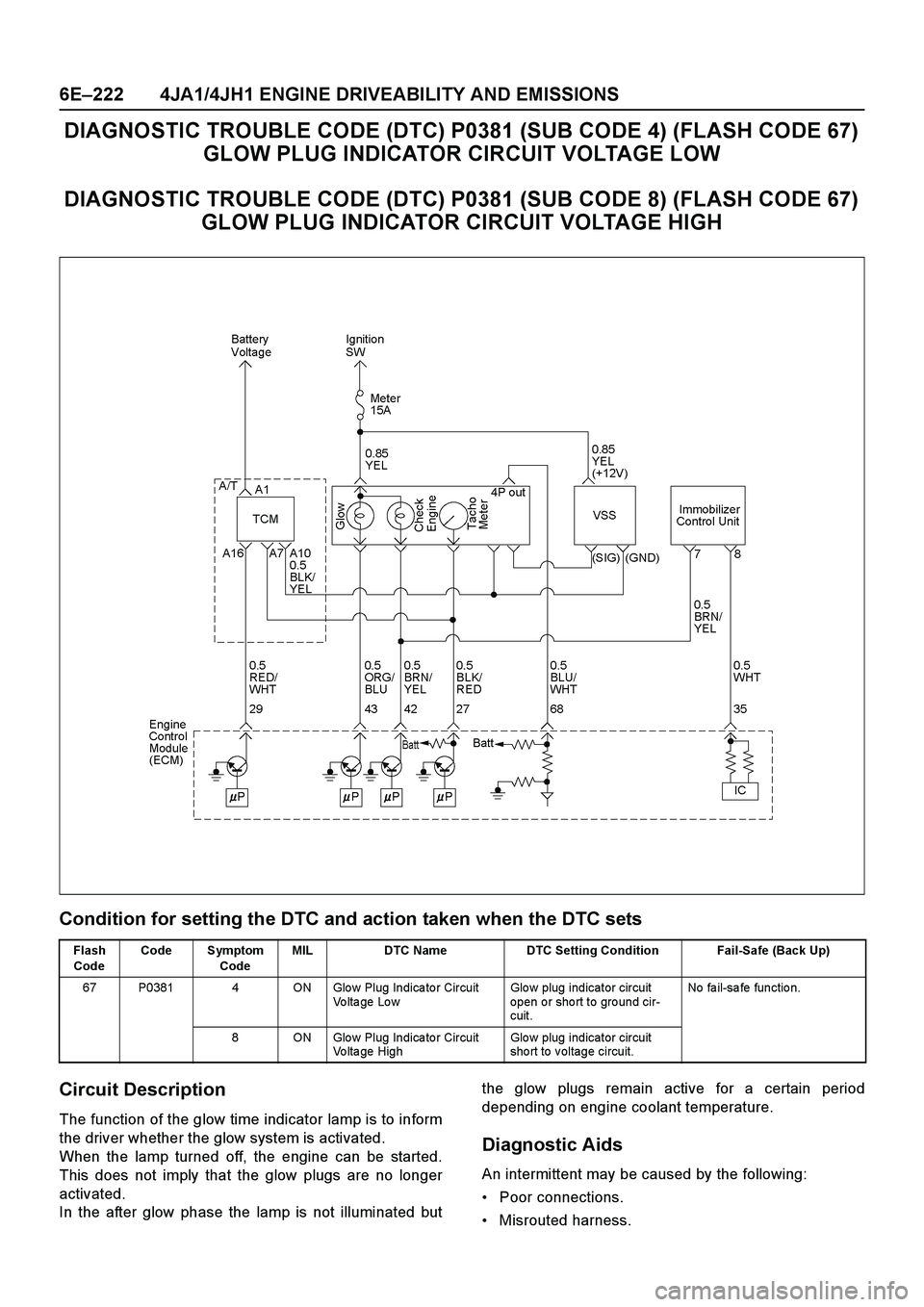
6E–222 4JA1/4JH1 ENGINE DRIVEABILITY AND EMISSIONS
DIAGNOSTIC TROUBLE CODE (DTC) P0381 (SUB CODE 4) (FLASH CODE 67)
GLOW PLUG INDICATOR CIRCUIT VOLTAGE LOW
DIAGNOSTIC TROUBLE CODE (DTC) P0381 (SUB CODE 8) (FLASH CODE 67)
GLOW PLUG INDICATOR CIRCUIT VOLTAGE HIGH
Condition for setting the DTC and action taken when the DTC sets
Circuit Description
The function of the glow time indicator lamp is to inform
the driver whether the glow system is activated.
When the lamp turned off, the engine can be started.
This does not imply that the glow plugs are no longer
activated.
In the after glow phase the lamp is not illuminated butthe glow plugs remain active for a certain period
depending on engine coolant temperature.
Diagnostic Aids
An intermittent may be caused by the following:
Poor connections.
Misrouted harness.
Flash
CodeCode Symptom
CodeMIL DTC Name DTC Setting Condition Fail-Safe (Back Up)
67 P0381 4 ON Glo w Plug Indica to r Circuit
Voltage LowGlo w plug indicator circuit
open or short to ground cir-
cuit.No fa il-sa fe fun ctio n.
8 ON Glo w Plug Indica to r Circuit
Vo lta ge HighGlo w plug indicator circuit
short to voltage circuit.
Page 1600 of 4264
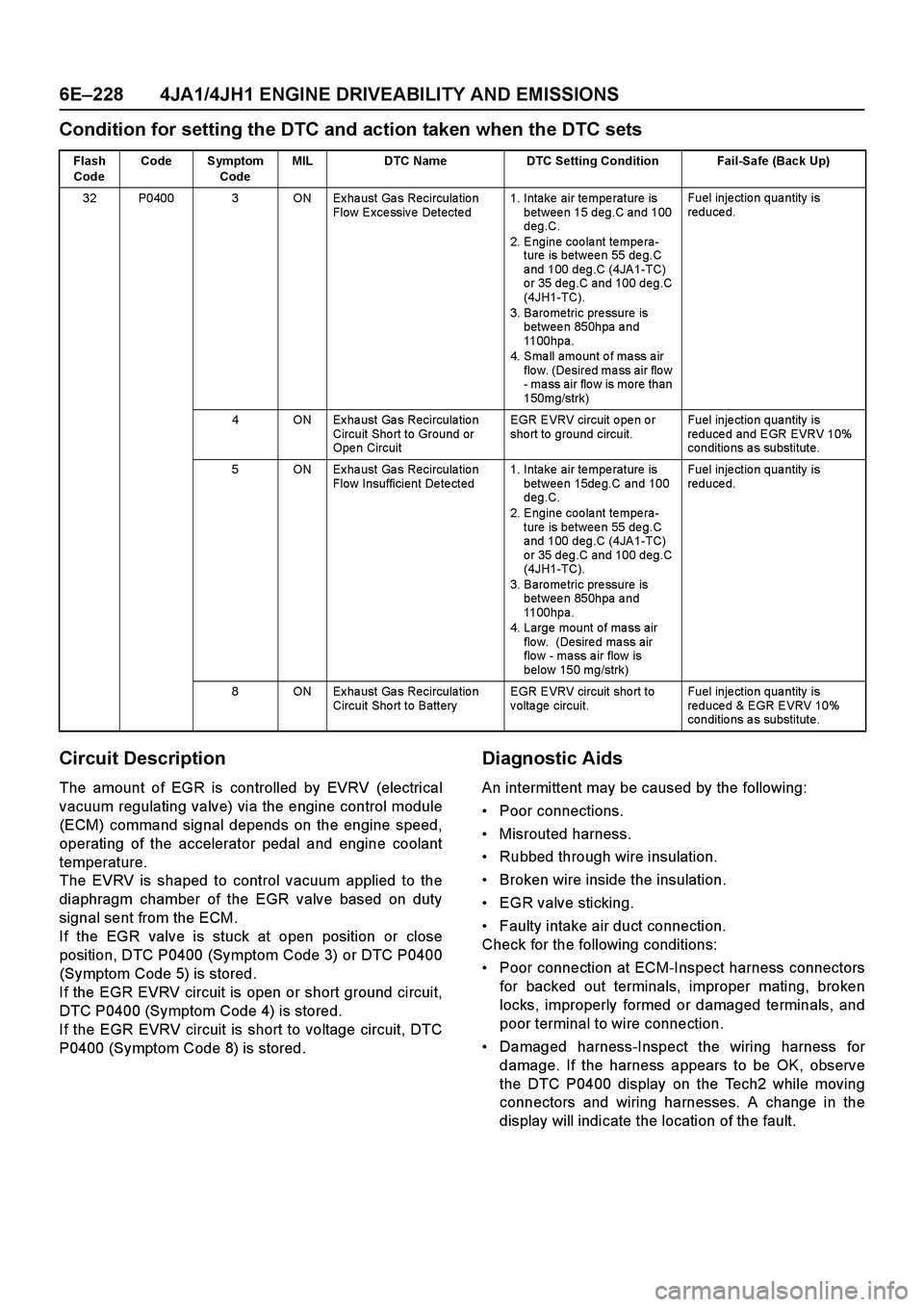
6E–228 4JA1/4JH1 ENGINE DRIVEABILITY AND EMISSIONS
Condition for setting the DTC and action taken when the DTC sets
Circuit Description
The amount of EGR is controlled by EVRV (electrical
vacuum regulating valve) via the engine control module
(ECM) command signal depends on the engine speed,
operating of the accelerator pedal and engine coolant
temperature.
The EVRV is shaped to control vacuum applied to the
diaphragm chamber of the EGR valve based on duty
signal sent from the ECM.
If the EGR valve is stuck at open position or close
position, DTC P0400 (Symptom Code 3) or DTC P0400
(Symptom Code 5) is stored.
If the EGR EVRV circuit is open or short ground circuit,
DTC P0400 (Symptom Code 4) is stored.
If the EGR EVRV circuit is short to voltage circuit, DTC
P0400 (Symptom Code 8) is stored.
Diagnostic Aids
An intermittent may be caused by the following:
Poor connections.
Misrouted harness.
Rubbed through wire insulation.
Broken wire inside the insulation.
EGR valve sticking.
Faulty intake air duct connection.
Check for the following conditions:
Poor connection at ECM-Inspect harness connectors
for backed out terminals, improper mating, broken
locks, improperly formed or damaged terminals, and
poor terminal to wire connection.
Damaged harness-Inspect the wiring harness for
damage. If the harness appears to be OK, observe
the DTC P0400 display on the Tech2 while moving
connectors and wiring harnesses. A change in the
display will indicate the location of the fault.
Flash
CodeCode Symptom
CodeMIL DTC Name DTC Setting Condition Fail-Safe (Back Up)
32 P0400 3 ON Ex ha ust Ga s Recircula tio n
Flow Excessive Detected1. Intake air temperature is
between 15 deg.C and 100
deg.C.
2. Engine coolant tempera-
ture is betwee n 55 de g.C
and 100 deg.C (4JA1-TC)
or 35 deg.C and 100 deg.C
(4JH1-TC).
3. Baro me tric pre ssure is
betwee n 850hpa a nd
1100hpa.
4. Small amount of mass air
flo w. (Desired ma ss air flo w
- mass air flow is more than
150mg/strk)Fuel inje ctio n qua ntity is
reduced.
4 ON Ex ha ust Ga s Recircula tio n
Circuit Sho rt to Ground or
Ope n CircuitEGR EVRV circuit open or
sho rt to ground circuit.Fuel inje ctio n qua ntity is
reduced and EGR EVRV 10%
conditio ns a s substitute.
5 ON Ex ha ust Ga s Recircula tio n
Flow Insufficient Detected1. Intake air temperature is
betwee n 15de g.C and 100
deg.C.
2. Engine coolant tempera-
ture is betwee n 55 de g.C
and 100 deg.C (4JA1-TC)
or 35 deg.C and 100 deg.C
(4JH1-TC).
3. Baro me tric pre ssure is
betwee n 850hpa a nd
1100hpa.
4. Large mount of mass air
flo w. (Desire d ma ss air
flo w - mass a ir flow is
below 150 mg/strk)Fuel inje ctio n qua ntity is
reduced.
8 ON Ex ha ust Ga s Recircula tio n
Circuit Sho rt to BatteryEGR EVRV circuit sho rt to
voltage circuit.Fuel inje ctio n qua ntity is
reduced & EGR EVRV 10%
conditio ns a s substitute.